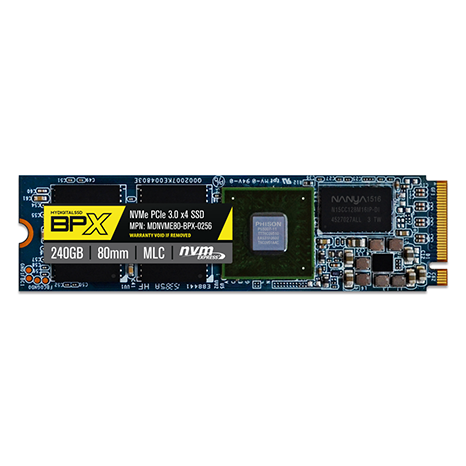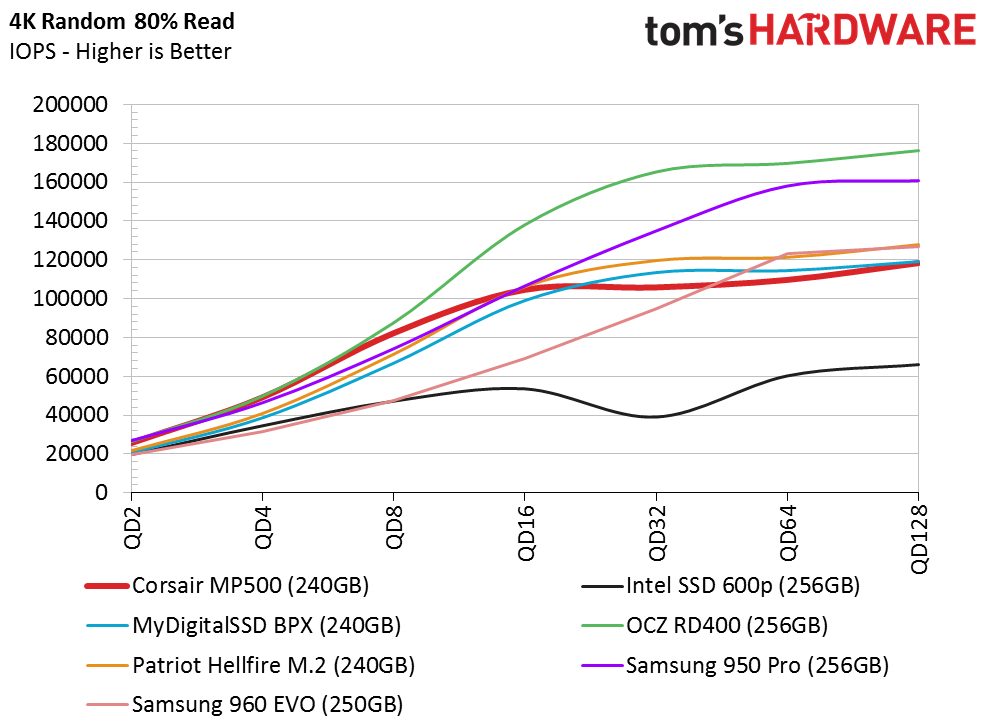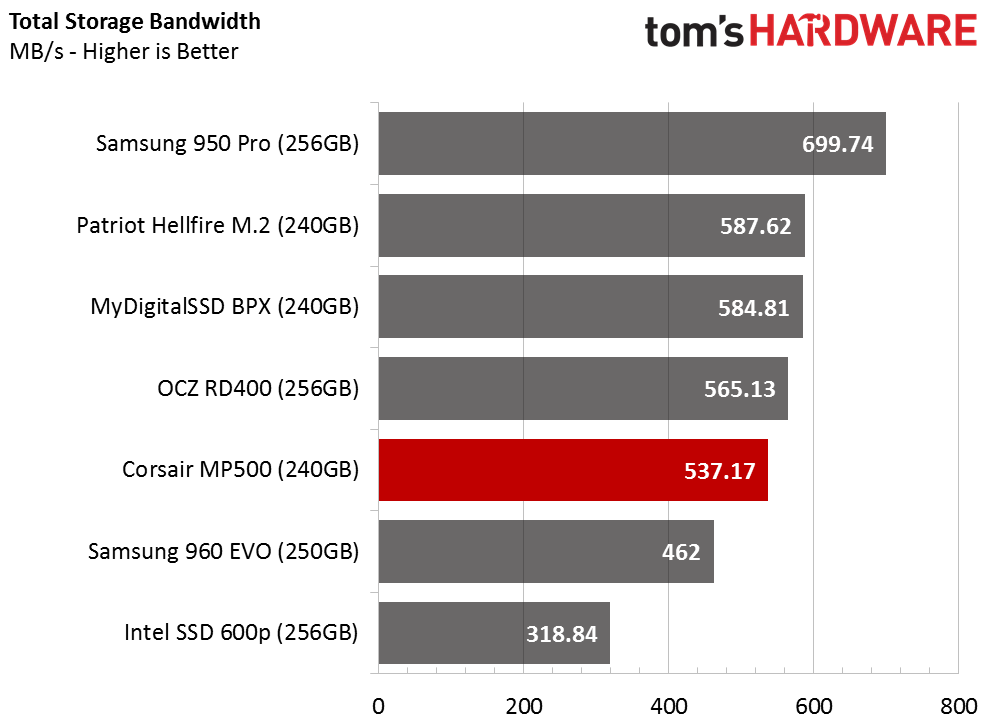Corsair Force Series MP500 M.2 NVMe SSD Review
Why you can trust Tom's Hardware
256GB Performance Testing
Comparison Products
The Corsair Force Series MP500 240GB sells for $169.99, which makes it one of the most expensive NVMe SSDs in our test pool. 240GB capacity SSDs are the starting point for many companies. The 256GB-class offers a better value for shoppers because they are priced only slightly higher than 128GB-class products. Pricing ranges from $103.99 (Intel 600p 256GB) to $169.99 (Corsair Force Series MP500 and OCZ RD400) and tops out at $214.99 (Samsung 950 Pro). The MyDigitalSSD BPX 240GB is our pick for the best overall value at $114.99.
Our tests highlight the performance of nearly every modern NVMe SSD available in the 256GB class. The Intel 600p and MyDigitalSSD BPX are the two low-cost models. The Patriot Hellfire M.2 and Samsung 960 EVO slot in the middle and we consider them to be mainstream products based on price and performance. The Corsair Force Series MP500 and OCZ RD400/RD400A join the Samsung 950 Pro at the top of the price range.
We are in the middle of a NAND flash drought, so pricing is subject to change on a daily, and sometimes hourly, basis. Some vendors have access to flash through other divisions inside the same company, but others have to purchase flash from fabs such as Toshiba, Micron, and SanDisk. Companies without guaranteed access to flash have found it difficult to buy the vital components at favorable prices for several months. The traditional price drops we normally see in the last quarter of the year evaporated due to the shortage. Prices have actually increased slightly in some popular capacities, and we expect more increases throughout the year.
Sequential Read Performance
To read about our storage tests in-depth, please check out How We Test HDDs And SSDs. We cover four-corner testing on page six of our How We Test guide.
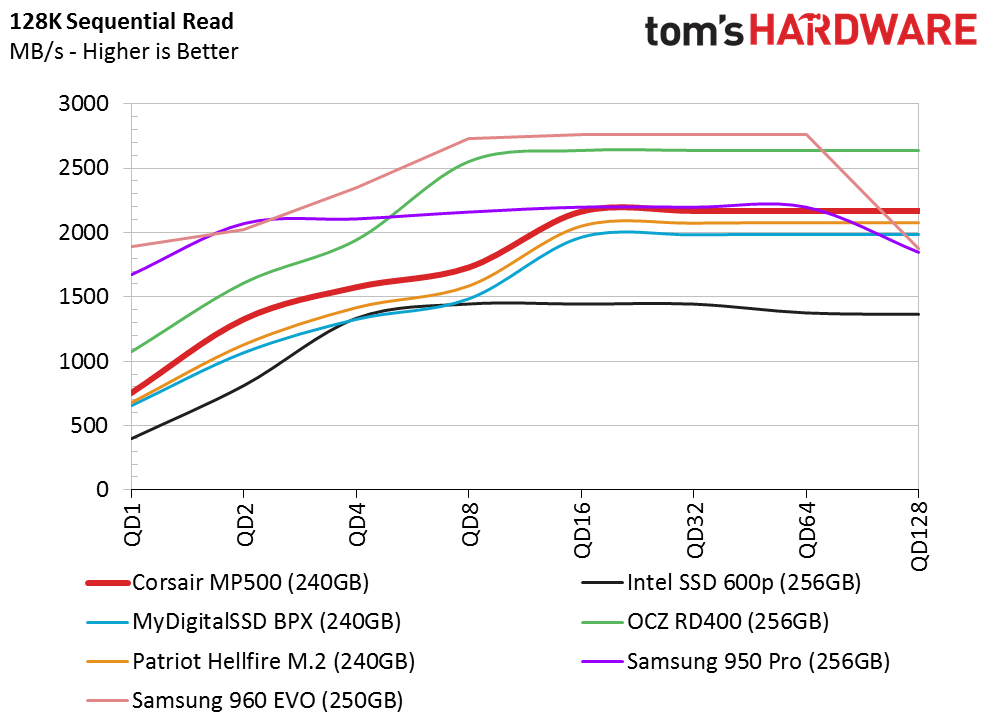
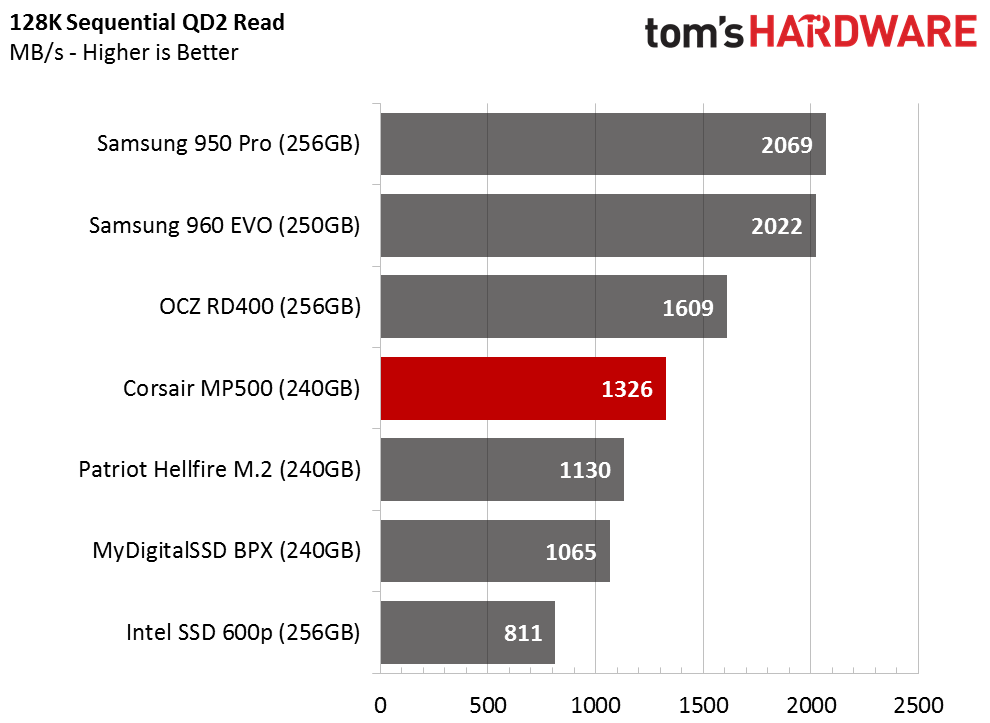
All the drives we tested are capable of delivering the manufacturer-quoted performance from their respective specifications. We measure performance differently than the manufacturers, so there is variation between the specifications and our performance numbers. We use a script to measure performance after preconditioning and a certain amount of idle time to show performance closer to what you should expect under normal use.
The Corsair Force Series MP500 has higher sequential performance compared to the E7-based Patriot Hellfire M.2 and MyDigitalSSD BPX. The performance profile as the E7 drives scale the QD range is nearly identical. The lead goes to the MP500 while the Hellfire M.2 occupies the middle. The BPX follows closely.
The Phison E7-based NVMe SSDs trail the OCZ RD400 and the Samsung products at QD1. The Samsung NVMe SSDs outperform the other products at QD1 by nearly 1,000 MB/s. As the queue depths increase, the performance lead shrinks for the Samsung SSDs.
Get Tom's Hardware's best news and in-depth reviews, straight to your inbox.
Sequential Write Performance

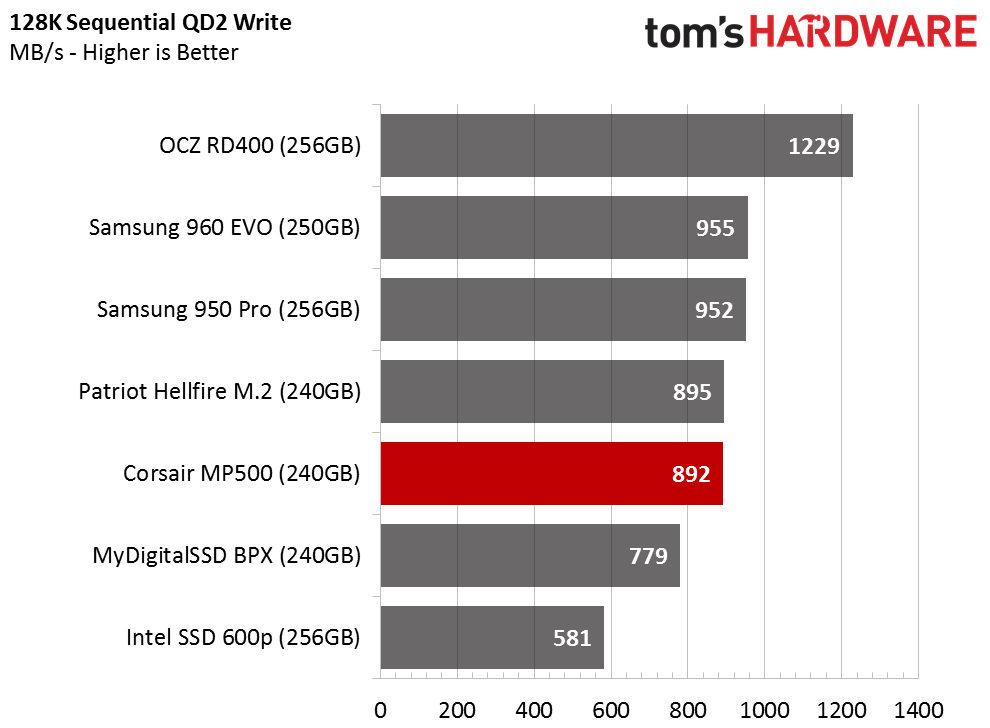
Our sequential write test recorded two odd peaks with the MP500 240GB. We typically don't see a lot of variation with MLC-based NVMe SSDs. The Samsung 960 EVO 250GB shows the same variation, but with performance dips rather than increases. This is more common on TLC-based NVMe SSDs like the 960 EVO.
Random Read Performance
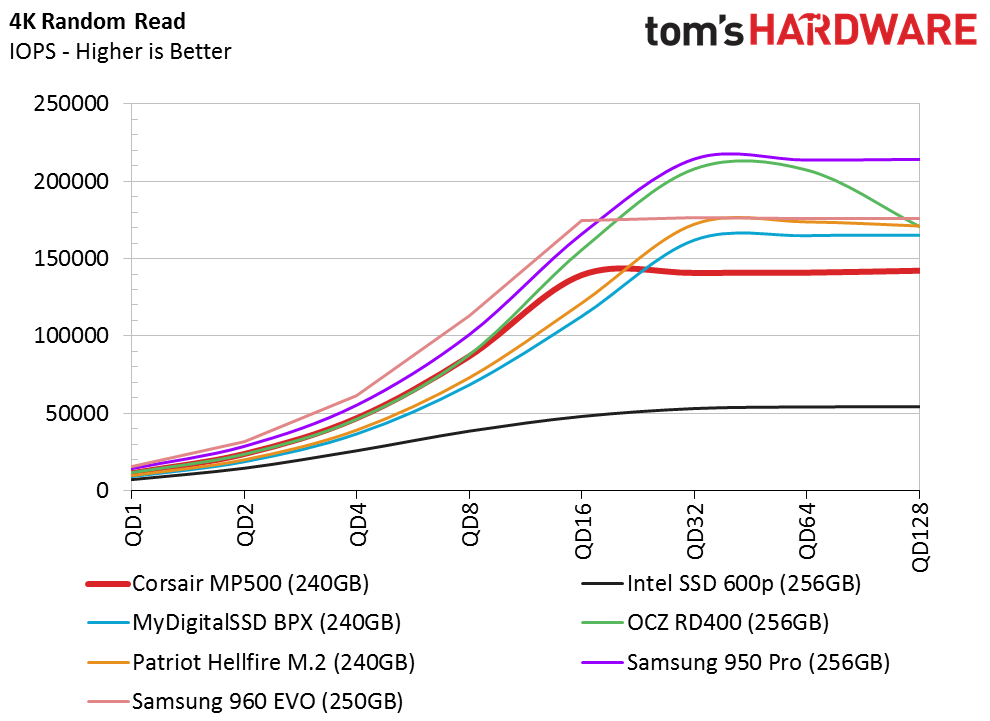


The MP500 240GB surpasses 10,000 random read IOPS at QD1. This is the first E7-based 240GB drive to achieve that milestone. It really goes to show that Corsair released the design to move the bar for this controller. The MP500 scales well as the QD increases, but the Toshiba planar NAND and E7 controller are still well behind Samsung's products at this capacity point.
Random Write Performance



This is where we began to examine the MP500's DRAM, which SSD controllers use to cache the LBA map. We found the capacity to be different than originally advertised. There is clearly a difference between the three PS5007-E7 products, but throughout the review, we'll see that no drive holds a strong advantage over another. The three drives shuffle back and forth at the top of different workloads, but in many cases, the differences are without the margin of error for each test.
80 Percent Sequential Mixed Workload
We describe our mixed workload testing in detail here and describe our steady state tests here.
The MP500 slots in the lower group at QD2 during the mixed sequential workload. The drive does provide increased performance as we increase the queue depth. There is an odd peak at QD64, but that is well above the typical range you will reach during normal use.
80 Percent Random Mixed Workload
The MP500 has slightly better low-QD performance compared to the other E7 SSDs during the mixed random test. The drive matches the OCZ RD400 for the highest QD2 and QD4 results.
Sequential Steady-State
The Corsair Force Series MP500 sits at the big-boy price table, so we view it as an entry-level workstation SSD like the Samsung 960 Pro and Intel SSD 750. Neither of those products sold in this capacity, but the 950 Pro was the de facto workstation NVMe SSD for all of 2016.
This test is a showdown of SSD processor (controller) muscle and its firmware, which controls the flow of data while still shuffling bits around to make room for incoming data. The E7 dominates the entry-level to mid-range but is less than ideal as a premium, top-tier priced product.
Random Steady-State


The MP500 240GB delivers high random IOPS performance during our random steady-state test. Inconsistent performance is the only issue we noticed. Some of the NVMe SSDS deliver less performance but sustain a more consistent data flow.
PCMark 8 Real-World Software Performance
For details on our real-world software performance testing, please click here.

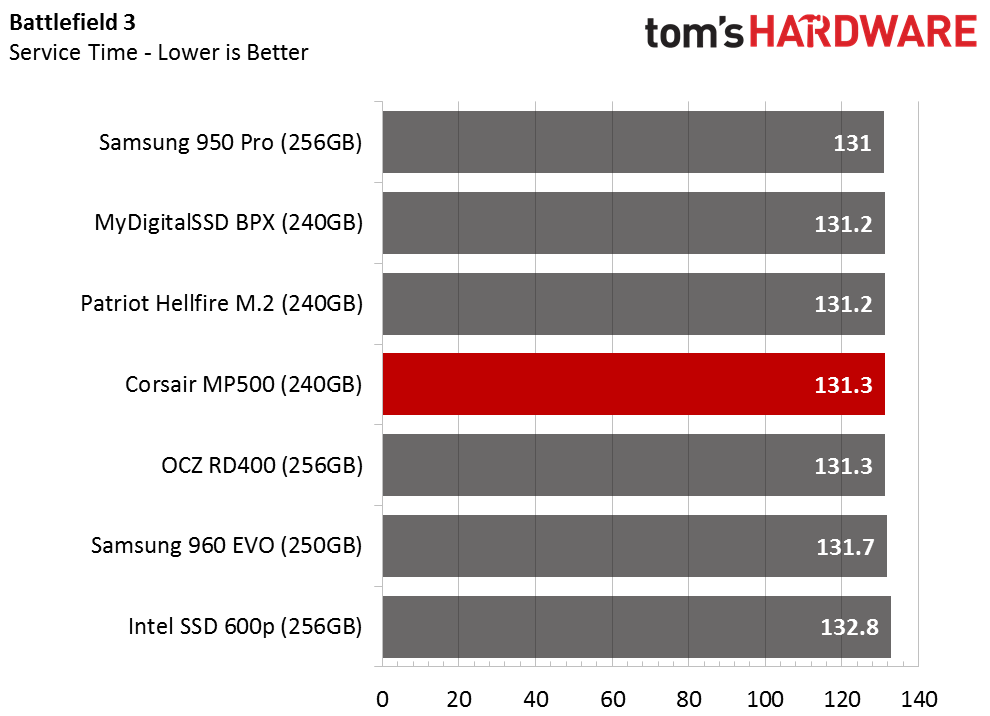


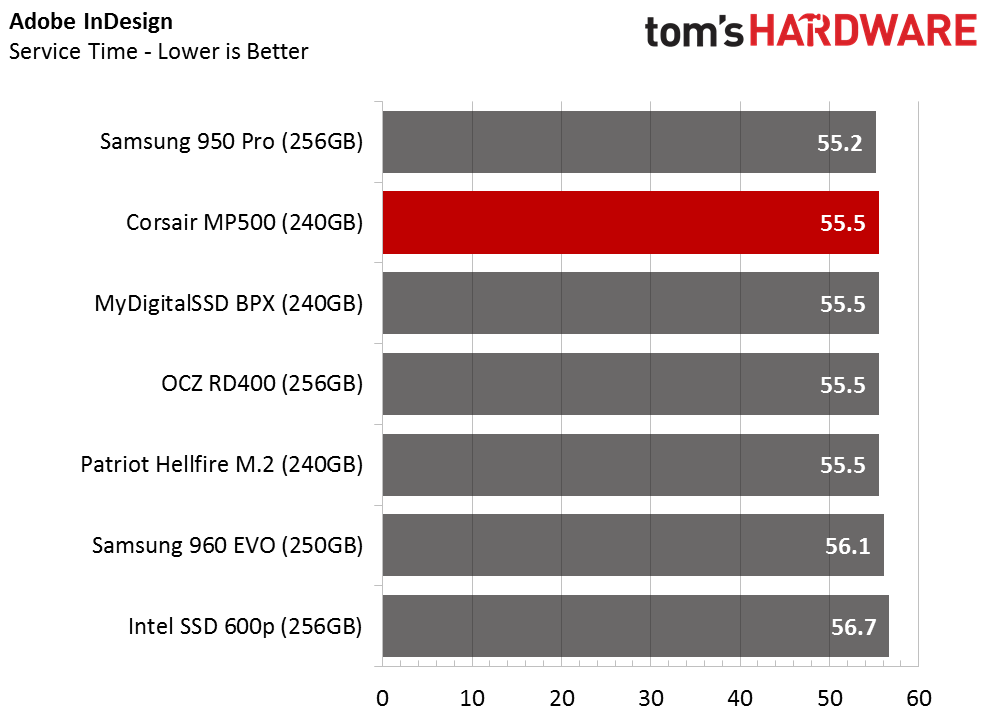


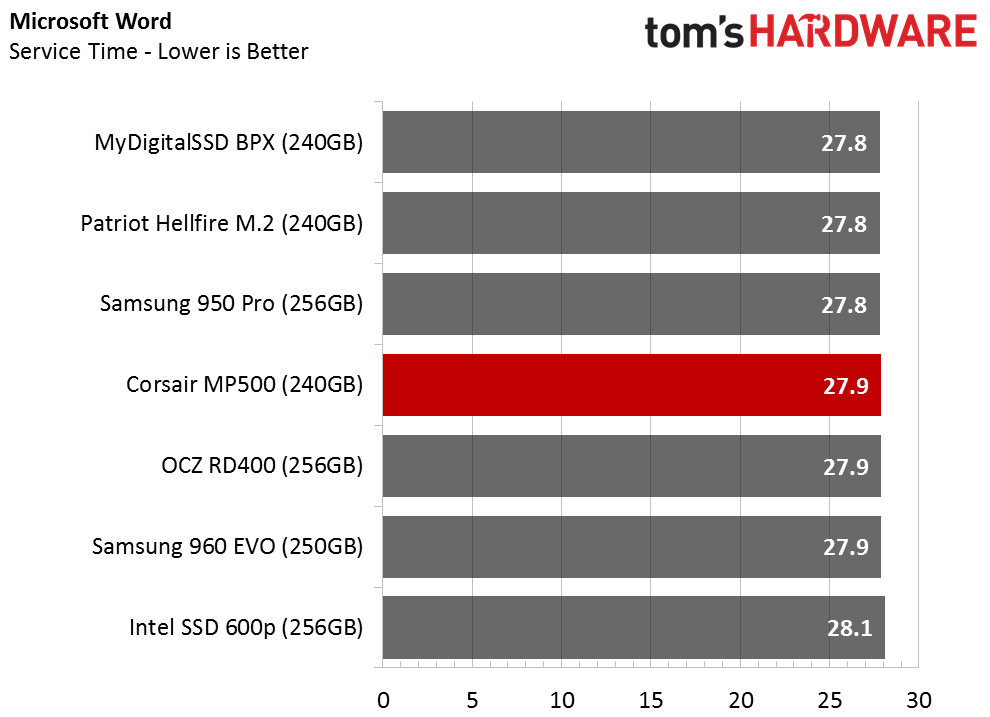


Many of these tests consist of light workloads at low queue depths. The Corsair Force Series MP500 240GB blends in with the other NVMe products with the same amount of capacity. Due to its premium pricing, we would like to see higher performance than what the drive actually achieved.
Application Storage Bandwidth
The averaged results show a middle cluster of drives that are very similar. The three E7 SSDs and the OCZ RD400 with a Toshiba controller deliver nearly identical performance, with each product working only slightly better than the other in specific tests.
The Samsung 960 EVO 250GB dominated many of the synthetic tests, but during real world workloads it trails the mainstream group. The 3-bit per cell (TLC) NAND is faster than the SATA 6Gb/s bandwidth limitation, so the other EVO series products could reach the performance limit of the raw NAND. With NVMe, the upper limit for TLC V-NAND becomes a factor so the drive just can't keep pace with MLC flash.
PCMark 8 Advanced Workload Performance
To learn how we test advanced workload performance, please click here.



You really have to understand what you are buying when you search for a premium SSD. The extra money should buy you higher write performance and higher sustained workload performance. Under heavy workloads, the Samsung 950 Pro and OCZ RD400 show us the type of performance a premium SSD should deliver. There is very little performance drop-off from the second portion of the test where the workload lightens as idle time increases.
The PCMark 8 test has been a staple of SSD testing for quite some time, so it's difficult to feel sorry for the Corsair MP500 with its high price-point and underwhelming sustained workload performance. Under lighter workloads, the MP500 compares favorably to the other products, but all the SSDs, except the Intel 600p and Samsung 960 EVO, are also right together.
Total Service Time


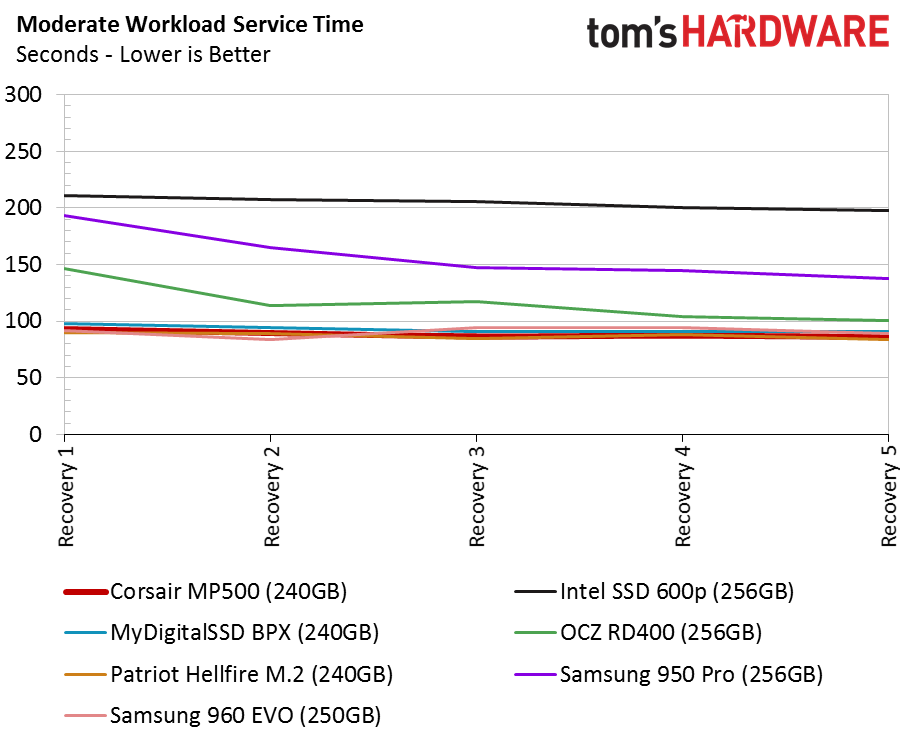
The service time test finds all three of the Phison E7-based drives tightly clustered together throughout the entire test. During heavy workloads, they perform slightly worse than the 950 Pro and RD400, but they outperform the other products when the workload lightens with idle time.
Disk Busy Time
The disk busy time test doesn't show us anything new with this set of SSDs.
Responsiveness Score
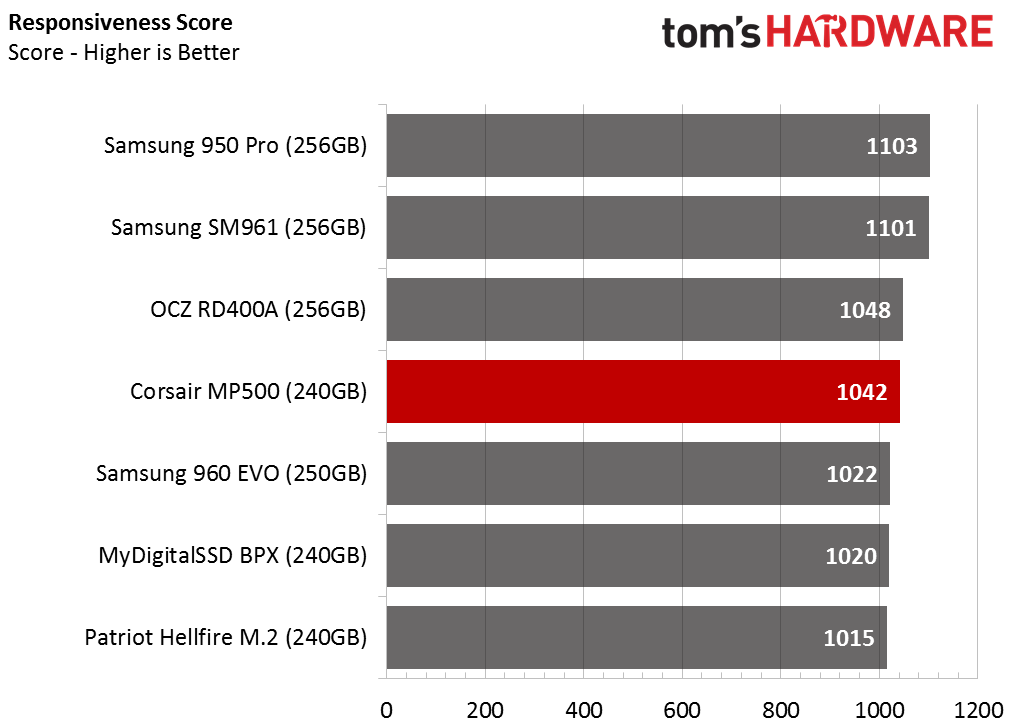

Our responsiveness test is a subset of BAPCo's new SYSmark 2014 SE. The performance scores are calculated using a low-cost Lenovo desktop base system with a Samsung planar TLC OEM SSD as a reference to define the 1000 score. A 2000 score would be twice as responsive compared to the base 1000 score. The watt-hour results quantify the amount of power used during the responsiveness test.
Look for a detailed editorial on this test and the Lenovo Y700-17 platform soon.
Notebook Battery Life
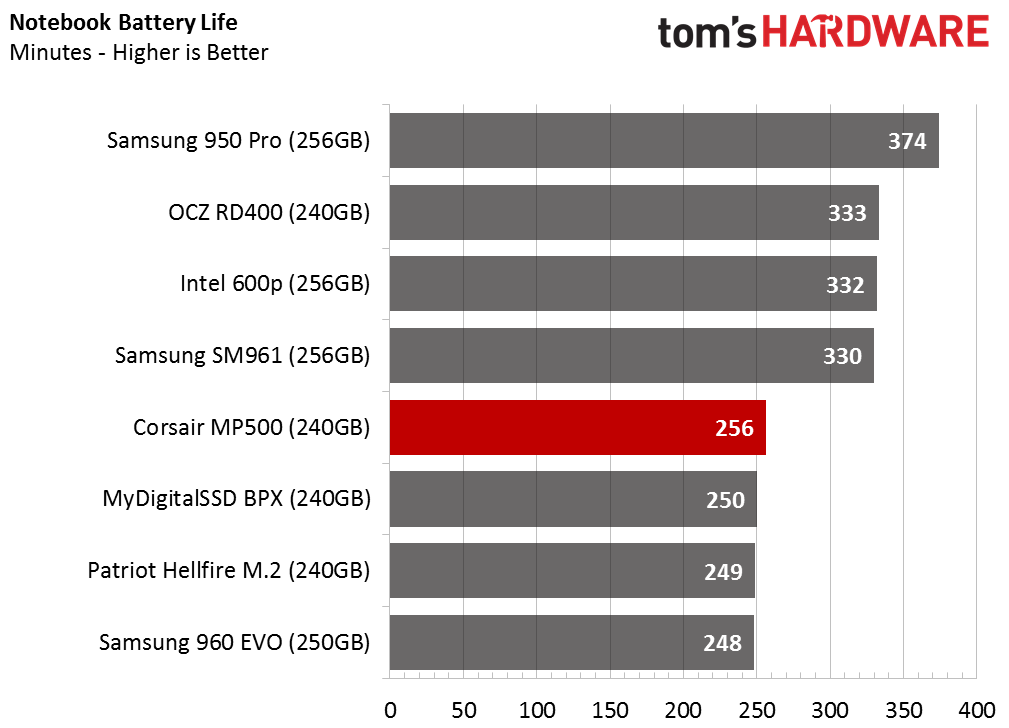

Our notebook battery life test also uses BAPCo (MobileMark 2014.5) software and the Lenovo Y700-17 gaming notebook. The system allows us to test both 2.5-inch SATA and M.2 2280 PCIe devices in the same system. This feat was not possible until the Y700, although it is now common to see both in modern gaming notebooks.
The Phison E7 NVMe SSDs have never performed very well in our notebook battery life test. Phison tells us the drives deliver more competitive on-battery performance in other systems. The company uses Acer systems for testing in its lab. We haven’t been able to confirm the disparity, but we do see similar results in our Lenovo P70 mobile workstation.
Current page: 256GB Performance Testing
Prev Page Specifications And Features Next Page 512GB Performance Testing
Chris Ramseyer was a senior contributing editor for Tom's Hardware. He tested and reviewed consumer storage.
-
bmguyii The real world tests seem to indicate that all of the choices are on par and that the diffs in the specialized tests mean nothing to real world. Buy the cheapest one with the best warranty that doesn't eat your battery life. Spending 2X for <1 second?Reply -
Bruce427 Not a bad review, but for about $55-$60 less (in the 240GB capacity) I will stick with the MyDigital BPX (2 year longer warranty and double the TBW endurance rating).Reply -
Nossy Meh, People still buy Corsair's memory and SSDs? I've never had one that lasted. Either a dead stick or a failed SSD. Stopped buying them for two years now. Crucial and Samsungs never gave me any problems.Reply -
xXBananasXx Reply
Bought a 4x4gb ddr3 1600mhz Corsair Vengeance back in 2012. Still running strong.19244999 said:Meh, People still buy Corsair's memory and SSDs? I've never had one that lasted. Either a dead stick or a failed SSD. Stopped buying them for two years now. Crucial and Samsungs never gave me any problems.
-
Elysian890 Reply19243373 said:typeo in the description of the RAM, it say MB instead of GB
1024MB = 1GB
No one's going to die because of that lol

